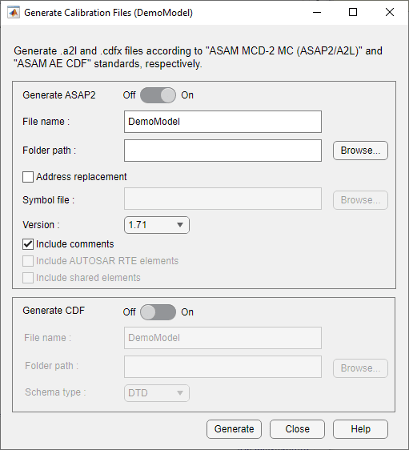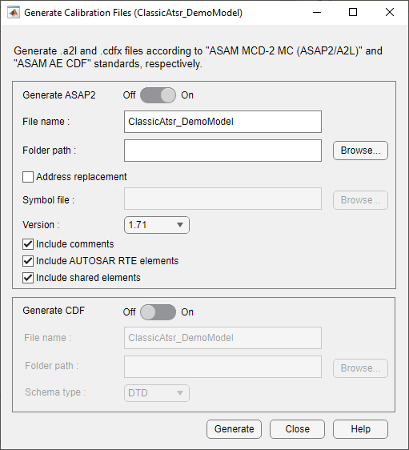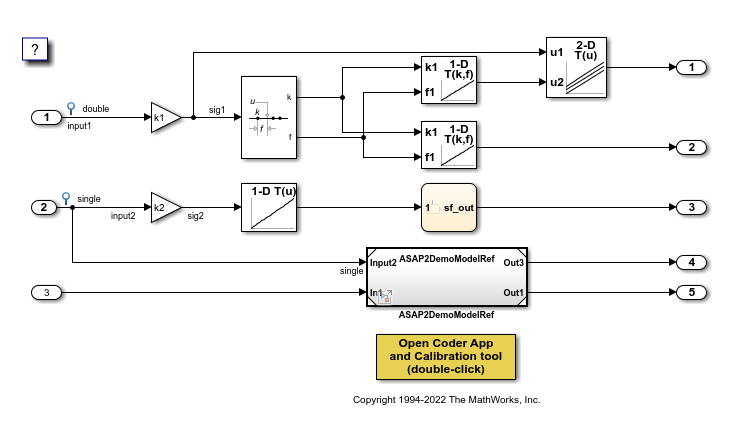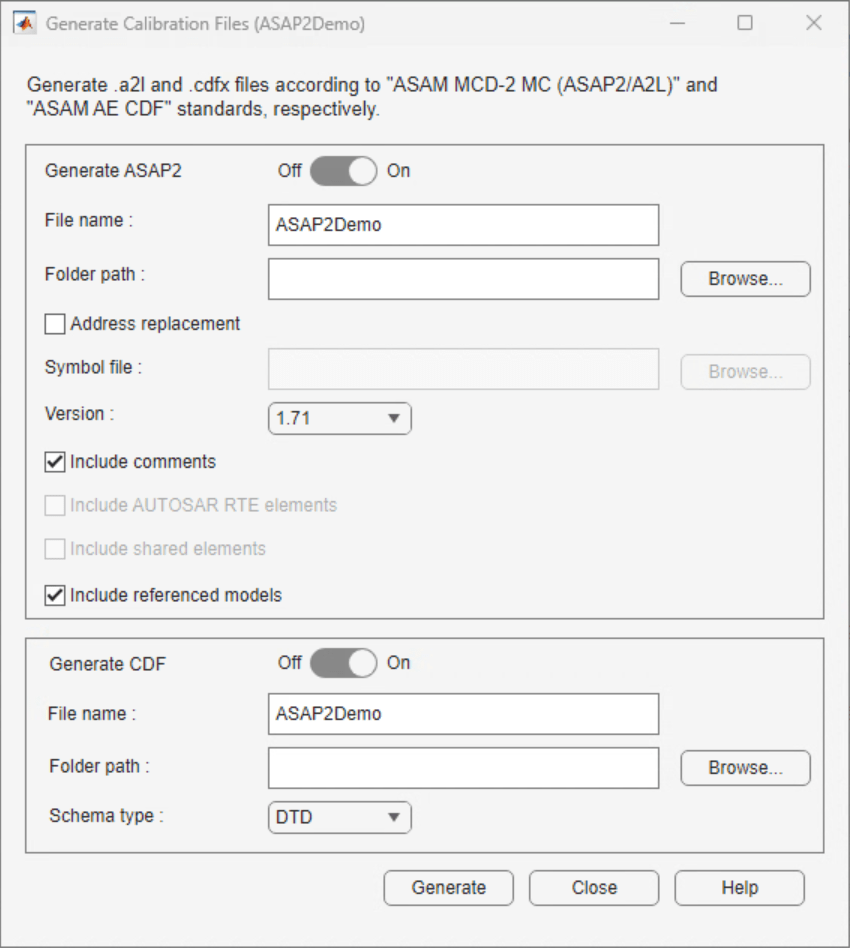生成 ASAP2 和 CDF 标定文件
使用生成标定文件工具为模型生成和自定义一个 ASAP2 文件和一个 CDF(标定数据格式)文件。默认情况下,该工具根据 ASAM MCD-2 MC 标准生成 A2L 文件的最新支持版本。您可以选择生成不同的版本。您可以自定义标定文件的选项,例如 A2L 文件的版本和 CDF 文件的架构类型。有关 ASAM MCD-2 MC (ASAP2) 标准和 ASAM CDF 标准的详细信息,请参阅 ASAM 网站 www.asam.net。
打开生成标定文件工具
打开模型。
打开 Embedded Coder。
注意
对于 AUTOSAR 模型,打开 AUTOSAR 组件设计器。对于 Simulink Real-Time 模型,打开 Simulink Coder。
为模型生成代码。
在 C 代码选项卡上,选择共享 > 生成标定文件。
注意
对于 AUTOSAR 模型,选择 Autosar > 共享 > 生成标定文件。

使用该工具,您可以同时为一个模型生成 A2L 和 cdfx 文件。您可以将该工具用于使用以下系统目标文件配置的模型:基于 ERT、基于 GRT、Simulink Real-Time、AUTOSAR Classic 或 AUTOSAR Adaptive 系统目标文件。该工具会记住上次使用的设置,如 ASAP2 文件的版本,包含或排除注释,包含或排除引用模型元素,关闭或打开 ASAP2 文件和 CDF 文件生成。Simulink 将这些设置保存在 MATLAB 预设项中。这些设置将覆盖默认设置。
对于 AUTOSAR Classic 模型,该工具允许您使用包括 AUTOSAR RTE 元素选项在 ASAP2 文件中包含或排除 RTE 元素。生成的 ASAP2 文件中的 RTE 元素将使用 RTE API 服务调用名称。

ASAP2 文件生成
ASAP2 定义当应用程序执行时用于调整参数和测量信号数据的内部 ECU 变量的描述格式。要生成 ASAP2 文件,请执行以下操作:
默认情况下,生成 ASAP2 选项处于启用状态。如果未启用,请将生成 ASAP2 开关滑动到打开位置以启用 A2L 生成。
要更改 A2L 文件的名称,请在文件名字段中指定名称。
默认情况下,代码生成器使用编译文件夹作为所选模型的文件夹路径。如果您要为 A2L 文件指定不同的文件夹路径,可以在文件夹路径字段中指定。
要替换 A2L 文件中的 ECU 地址,请在符号文件字段中提供与应用程序可执行文件相关联的符号文件。否则,请取消选中地址替换字段。
该工具支持 ELF、PDB 或 DWARF 文件作为替换 ECU 地址的符号文件。
将版本设置为要生成的 A2L 文件的所需版本。默认版本是 1.71。
要排除 A2L 文件中的注释,请取消选中包括注释。
要排除 A2L 文件中的引用模型元素,请清除包括引用模型。
对于 AUTOSAR Classic 模型,要排除 A2L 文件中的 RTE 元素,请清除包括 AUTOSAR RTE 元素。
要排除为 CompuMethods 和记录布局生成单独的文件,请清除包括共享元素。
要排除 A2L 文件中的引用模型数据元素,请清除包括引用模型。
点击生成。
要以编程方式生成 A2L 文件,请使用 coder.asap2.export 函数。
CDF 文件生成
ASAM CDF 定义用于存储 ECU 参数值和相关联的元数据的数据描述格式。ASAM CDF 文件使用 XML 格式,您可以通过标定工具和 XML 编辑器轻松地验证、编辑、导入和导出 XML 格式的文件。要使用该工具生成 CDF 文件,请执行以下操作:
将生成 CDF 开关滑动到打开位置。
要更改 CDF 文件的名称,请在文件名字段中指定更改后的名称。
默认情况下,代码生成器选择编译文件夹作为所选模型的文件夹路径。如果要为 CDF 文件指定不同文件夹路径,请在文件夹路径字段中指定路径。
使用架构类型字段设置为 XSD(XML 架构定义)或 DTD(文档类型定义)。DTD 是默认架构类型。
要以编程方式生成 CDF 文件,请使用 coder.cdf.export 函数。
注意
CDF 文件生成对 Simulink Real-Time 系统目标文件不可用。
生成 ASAP2 和 CDF 数据定义文件
此示例说明如何使用“生成标定文件”工具导出 ASAP2 和标定数据格式 (CDF) 文件以进行数据测量和标定。
ASAP2 标准定义用于测量和标定的内部电子控制单元 (ECU) 变量的描述格式,ASAM CDF 标准定义用于存储 ECU 参数值和相关联元数据的数据。这些标准由自动化和测量系统标准化协会 (ASAM) 提出。有关 ASAM MCD-2 MC 和 ASAM CDF 标准的详细信息,请参阅 www.asam.net。
此示例使用 ASAP2Demo.slx 和 ASAP2DemoModelRef.slx 模型。
编译 ASAP2Demo 模型
打开 ASAP2Demo 模型。
open_system("ASAP2Demo");编译该模型,为父模型 ASAP2Demo 和子模型 ASAP2DemoModelRef 生成 C 代码。
slbuild("ASAP2Demo");
打开“生成标定文件”工具
在 C 代码选项卡上,选择共享 > 生成标定文件以打开“生成标定文件”工具。

您可以自定义标定文件生成设置,如文件名、目标文件夹以及在文件中包含或排除注释。
生成 ASAP2 文件
按照以下步骤为模型生成 ASAP2 文件。
将生成 ASAP2 开关移动到打开位置。默认情况下,生成 ASAP2 开关处于打开位置。
在文件名字段中指定一个名称以更改来自 ASAP2Demo 的文件的名称。
在文件夹路径字段中指定 A2L 文件的路径。默认情况下,A2L 文件在编译目录中生成。
在符号文件字段中提供与应用程序可执行文件相关联的符号文件,以替换 A2L 文件中的 ECU 地址。否则,请取消选中地址替换字段。该工具支持 ELF、PDB、DWARF 文件作为替换 ECU 地址的符号文件。
将版本选项设置为要生成的 A2L 文件的所需版本。默认版本是 1.71。
取消选中包括注释选项,以排除 A2L 文件中的注释。
取消选中包含引用模型选项,以排除 A2L 文件中的引用模型数据元素。
点击生成。
要以编程方式生成 A2L 文件,请使用以下命令。
coder.asap2.export("ASAP2Demo");生成 CDF 文件
按照以下步骤为模型生成 CDF 文件。
将生成 CDF 开关移动到打开位置。默认情况下,生成 CDF 开关处于打开位置。
在文件名字段中指定一个名称以更改来自 ASAP2Demo 的文件的名称。
在文件夹路径字段中指定 CDF 文件的文件夹路径。默认情况下,CDF 文件在编译目录中生成。
选择架构类型字段作为 XML 架构定义 (XSD) 或文档类型定义 (DTD)。默认情况下,它设置为 DTD 架构类型。
点击生成。
要以编程方式生成 CDF 文件,请使用以下命令。
coder.cdf.export("ASAP2Demo");您可以验证标定文件是否在指定的文件夹中生成。现在,您可以使用这些标定文件来标定和测量应用程序。
另请参阅
coder.cdf.export | coder.asap2.export | 生成标定文件